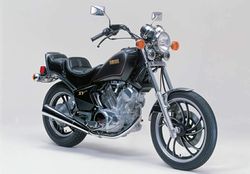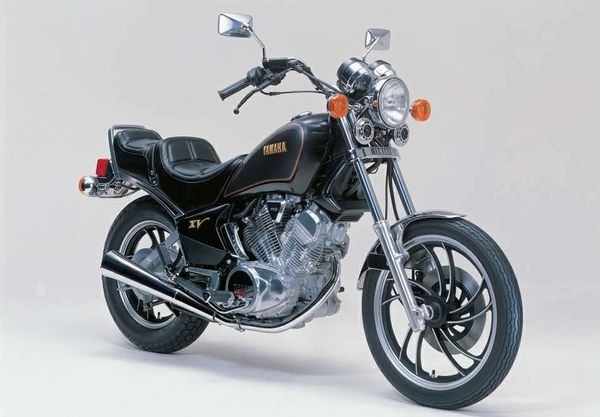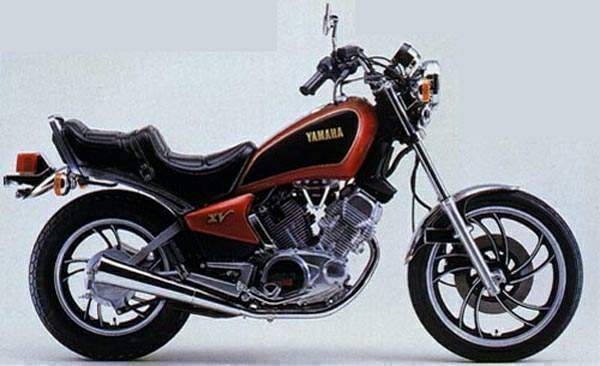Difference between revisions of "Yamaha XV400"
m (Kylebass moved page Yamaha XV400 Virago to Yamaha XV400) |
(template fixes) |
||
| (5 intermediate revisions by 2 users not shown) | |||
| Line 1: | Line 1: | ||
{{ | {{Motorcycle | ||
|name = | |name = Yamaha XV400 Virago | ||
| | |photo = Yamaha-XV400-Virago-83.jpg | ||
|aka = | |aka = | ||
|manufacturer = Yamaha | |manufacturer = Yamaha | ||
| Line 9: | Line 9: | ||
|predecessor = | |predecessor = | ||
|successor = | |successor = | ||
|class = | |class = Cruiser | ||
|engine = Four stroke, 70°V-Twin cylinder, SOHC, 2 valves per cylinder. | |engine = Four stroke, 70°V-Twin cylinder, SOHC, 2 valves per cylinder. | ||
|bore_stroke = | |bore_stroke = | ||
| Line 37: | Line 37: | ||
|fuel_capacity = 8.6 Liters / 2.2 US gal | |fuel_capacity = 8.6 Liters / 2.2 US gal | ||
|oil_capacity = | |oil_capacity = | ||
|oil_filter = K&N KN-145 | |||
|recommended_oil=Yamalube 10w-40 | |||
|fuel_consumption = | |fuel_consumption = | ||
|turning_radius = | |turning_radius = | ||
| Line 43: | Line 45: | ||
}} | }} | ||
The Virago was Yamaha's first V-twin cruiser motorcycle, and one of the earliest mass-produced motorcycles with a | |||
mono-shock rear suspension. Originally sold with a 750 cc (46 cu in) | |||
engine in 1981, Yamaha soon added 500 cc (31 cu in) and 900 cc (55 cu in) versions. | |||
The bike was redesigned in 1984, switching from a rear mono-shock to a dual-shock design, and adding a tear-drop shaped gas tank. | |||
That year, Harley-Davidson, fearful of the inroads in the US market made by the | |||
Virago and other new Japanese cruiser-style motorcycles, pushed for a tariff on | |||
imported bikes over 700 cc. Yamaha replaced the 750 cc engine with a 699 cc | |||
version to avoid the tariff, while the 920 cc engine grew to 1000 cc, and later | |||
1100 cc. In the late 1980s a 250 cc Virago was added. A short production of | |||
125 cc was also manufactured. Yamaha made a [[Yamaha XV125|XV125]], [[Yamaha XV250|XV250]], XV400, [[Yamaha XV500|XV500]], [[Yamaha XV535|XV535]], | |||
[[Yamaha XV700|XV700]], [[Yamaha XV750|XV750]], [[Yamaha XV920R|XV920R]], XV1000/TR1, [[Yamaha XV1100|XV1100]], the XV400SCLX being the rarest of the breed. | |||
The larger-displacement Viragos were eventually phased out of production, replaced by the V-Star and Road Star series of motorbikes. The last motorcycle to bear the Virago name was the 2007 Virago 250. | |||
For 2008 it was renamed to the V-Star 250. | |||
According to ''Motorcyclist'' magazine, the early Virago has a design flaw in the starter system. This magazine states that the starter's defect exists in early Viragos models, and will catch the rider on | |||
fire in rare cases, models made in year 1982 and 1983. | |||
| Line 57: | Line 75: | ||
[[File:Yamaha-XV400S-83.jpg|600px|Yamaha XV400 Virago]] | [[File:Yamaha-XV400S-83.jpg|600px|Yamaha XV400 Virago]] | ||
== | == Specifications == | ||
{| class="wikitable" | {| class="wikitable" | ||
|- | |- | ||
| Line 194: | Line 167: | ||
|} | |} | ||
[[Category:Yamaha motorcycles]] | [[Category:Yamaha motorcycles]] | ||
[[Category:Cruiser motorcycles]] | |||
Latest revision as of 22:35, 23 November 2019
 |
|
| Yamaha XV400 Virago | |
| Manufacturer | |
|---|---|
| Production | 1984 - 86 |
| Class | Cruiser |
| Engine | Four stroke, 70°V-Twin cylinder, SOHC, 2 valves per cylinder. |
| Compression ratio | 9.7:1 |
| Ignition | CDI |
| Transmission | 5 speed constant mesh |
| Suspension | Front: Telescopic forks Rear: Dual shocks with preload adjustment |
| Brakes | Front: Single disc with single-piston caliper Rear: 200 mm Drum |
| Front Tire | 3.00S19 4PR |
| Rear Tire | 140/90 15 M/C 70S |
| Wheelbase | 1511 mm / 59.4 in |
| Seat Height | 700 mm / 27.5 in |
| Weight | 178 kg / 392 lbs (dry), 185 kg / 407.8 lbs (wet) |
| Oil Filter | K&N KN-145 |
| Recommended Oil | Yamalube 10w-40 |
| Fuel Capacity | 8.6 Liters / 2.2 US gal |
| Manuals | Service Manual |
The Virago was Yamaha's first V-twin cruiser motorcycle, and one of the earliest mass-produced motorcycles with a
mono-shock rear suspension. Originally sold with a 750 cc (46 cu in)
engine in 1981, Yamaha soon added 500 cc (31 cu in) and 900 cc (55 cu in) versions.
The bike was redesigned in 1984, switching from a rear mono-shock to a dual-shock design, and adding a tear-drop shaped gas tank.
That year, Harley-Davidson, fearful of the inroads in the US market made by the
Virago and other new Japanese cruiser-style motorcycles, pushed for a tariff on
imported bikes over 700 cc. Yamaha replaced the 750 cc engine with a 699 cc
version to avoid the tariff, while the 920 cc engine grew to 1000 cc, and later
1100 cc. In the late 1980s a 250 cc Virago was added. A short production of
125 cc was also manufactured. Yamaha made a XV125, XV250, XV400, XV500, XV535,
XV700, XV750, XV920R, XV1000/TR1, XV1100, the XV400SCLX being the rarest of the breed.
The larger-displacement Viragos were eventually phased out of production, replaced by the V-Star and Road Star series of motorbikes. The last motorcycle to bear the Virago name was the 2007 Virago 250.
For 2008 it was renamed to the V-Star 250.
According to Motorcyclist magazine, the early Virago has a design flaw in the starter system. This magazine states that the starter's defect exists in early Viragos models, and will catch the rider on fire in rare cases, models made in year 1982 and 1983.
Engine[edit | edit source]
The engine was a Air cooled cooled Four stroke, 70°V-Twin cylinder, SOHC, 2 valves per cylinder.. The engine featured a 9.7:1 compression ratio.
Drive[edit | edit source]
Power was moderated via the Wet multi-plate, cable operated.
Chassis[edit | edit source]
It came with a 3.00S19 4PR front tire and a 140/90 15 M/C 70S rear tire. Stopping was achieved via Single disc with single-piston caliper in the front and a 200 mm Drum in the rear. The front suspension was a Telescopic forks while the rear was equipped with a Dual shocks with preload adjustment. The XV400 Virago was fitted with a 8.6 Liters / 2.2 US gal fuel tank. The bike weighed just 178 kg / 392 lbs. The wheelbase was 1511 mm / 59.4 in long.
Photos[edit | edit source]
Specifications[edit | edit source]
| Make Model | Yamaha XV 400 Virago |
|---|---|
| Year | 1984 - 86 |
| Engine Type | Four stroke, 70°V-Twin cylinder, SOHC, 2 valves per cylinder. |
| Displacement | 399 cc / 24.3 cu-in |
| Bore X Stroke | 68 х 55 mm |
| Cooling System | Air cooled |
| Compression | 9.7:1 |
| Induction | 2 x 34 mm Mikuni carburettors |
| Ignition | CDI |
| Starting | Electric |
| Max Power | 40 hp / 29.8 kW @ 8500 rpm |
| Max Torque | 3.5 kgf-m / 25.3 lb-ft @ 7000 rpm |
| Clutch | Wet multi-plate, cable operated |
| Transmission | 5 speed constant mesh |
| Final Drive | shaft |
| Front Suspension | Telescopic forks |
| Rear Suspension | Dual shocks with preload adjustment |
| Front Brakes | Single disc with single-piston caliper |
| Rear Brakes | 200 mm Drum |
| Front Tire | 3.00S19 4PR |
| Rear Tire | 140/90 15 M/C 70S |
| Rake | 31.5° |
| Trail | 125 mm / 4.9 in |
| Wheelbase | 1511 mm / 59.4 in |
| Seat Height | 700 mm / 27.5 in |
| Ground Clearance | 145 mm / 5.7 in |
| Dry Weight | 178 kg / 392 lbs |
| Wet Weight | 185 kg / 407.8 lbs |
| Fuel Capacity | 8.6 Liters / 2.2 US gal |

